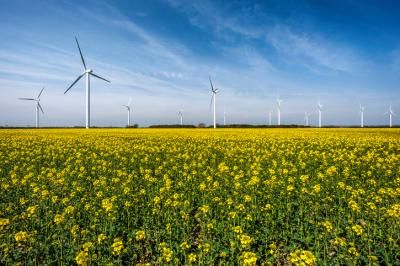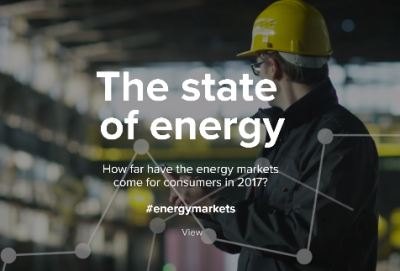- Dermot Nolan
- Publication date
- Industry sector
- Distribution Network
- Generation and Wholesale Market
- Supply and Retail Market
- Transmission Network
Renewables now provide around a quarter of total electricity generation, compared to 5% in 2006. Meanwhile, there are now over 60 energy suppliers, 16 more than a year earlier, according to our new State of the Energy Market 2017 report that we’ve launched today.
Energy markets are rapidly changing to meet our need for clean, secure and affordable energy and to accommodate a transformation in the way we consume energy.
The pace and scale of changes are unlike anything we’ve ever seen in the sector. They’ve been helped by major investments in generation, networks and energy efficiency.
But the benefits of these investments will only flow to consumers if energy markets work well.
Our new State of the Market report draws together evidence from across the industry and from us, to give an overview of the market at the moment. It focuses on four areas - competition, vulnerability, decarbonisation and security of supply – to shed light on one question. Is the market working for consumers?
Is competition working?
Since 2012, new suppliers have intensified competition in the retail sector, shrinking the six largest energy suppliers’ share of the market from nearly all customers to just over 80% of consumers.
It’s a huge change. With greater choice out there, and if you’re a switched-on consumer able to seek out good deals, competition will help you reduce the cost of your energy.
Competition in the wholesale gas and electricity markets is working reasonably well, with no company able to exploit a dominant position. Following a long-term fall, wholesale prices, which reflect global prices, are just beginning to creep up or stabilise. However, if competition was working really well, we'd expect to see the benefits felt by all consumers.
That’s not the case at the moment. More than half of consumers (58%) have never switched supplier or have switched only once. 60% of consumers are on variable ‘default’ tariffs, which can be around £300 more expensive each year than the cheapest fixed-term deals.
Some progress is being made; the number of customers on poor value tariffs has fallen over two years, as millions switched away from SVTs or had their prices protected by the pre-payment meter safeguard tariff. However, it’s not happening far or fast enough.
So we’re trialling radical new measures to get more disengaged people switching. Meanwhile, we’re working with the government to cap the bills of those on the worst value tariffs.
Are bills affordable?
Whilst bills have dropped since their peak in 2013, they are still higher in real terms than they were 10 years ago.
So, whilst the proportion of households in fuel poverty has remained stable since 2003, they are in greater need because their bills are higher. And, fuel poverty is increasingly affecting children and young people.
It’s a paradox that those who can afford their bills are more likely to get good deals anyway. Meanwhile, those on the lowest incomes tell us they’re least likely to have switched supplier.
This disparity is unacceptable. We’re taking action to protect the prices paid by one million vulnerable customers this winter, with potentially two million more in future.
Are we getting greener?
Our energy mix is changing to become much cleaner and greener.
In 2016, the UK emitted 58% of the greenhouse gasses it did in 1990. Over the past decade, over half these reductions have come from cleaner electricity. Each unit is now 64% cleaner than in 1990.
Low-carbon polices which cost £7.4 billion - equivalent to around £90 for the typical household - have driven the reduction in emissions. The CMA found that a lack of competition in awarding contracts has driven up cost.
This is changing, however. Generators now have to compete to get subsidies, which is bringing down costs, for example driving down costs for offshore wind schemes. New wind turbines in 2022 will cost half the amount new turbines cost in 2017.
However, we’re making much slower progress on bringing down emissions in buildings heating and transport.
So, whilst the UK is on course to achieve emissions reductions targets to 2022, beyond that it looks more uncertain. To meet our future targets, we need more investment and policies in place in the long term to improve carbon capture and storage, drive forward low emissions transport and more low-carbon heating of buildings heating, and increase renewable electricity generation.
Will the lights stay on?
Great Britain has kept energy supplies secure without substantial intervention to balance supply and demand.
Keeping the lights on requires the energy system to be working well, reliably, and to be resilient to demand and supply shocks.
Our gas supplies are diverse – with 38 % from our own fields and 42% from Norway - limiting our exposure to shocks. Our gas infrastructure can deliver 600m cubic metres per day, and if this wasn’t enough for whatever reason, National Grid can take emergency measures to maintain demand and supply.
In future, the new Capacity Market should secure supplies at least cost to consumers. This will substantially depend on the quality of forecasting.
The future
Energy is an essential service and Ofgem works to ensure that the markets function in the interest of all consumers.
This report will provide Ofgem with a crucial evidence-based annual assessment that will help inform the way we regulate to protect consumers, now and in the future.
We hope it shines a light on how well the markets are working, for everyone with an interest in gas and electricity.
More on the report
State of energy short-read
Join Ofgem's Chief Economist Joe Perkins in his overview of the markets today.
State of energy podcast
Listen to Ofgem’s Head of Analytical Strategy and Economics Community, Maureen Paul, explain the key findings and big data in-depth in our downloadable podcast.
Subscribe
If you'd like to get our insights and updates straight to your inbox, please subscribe.

